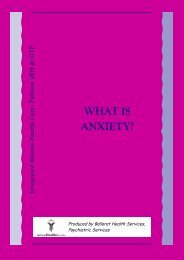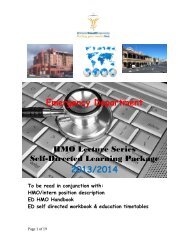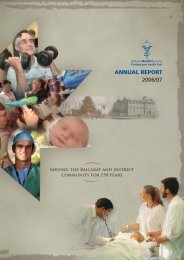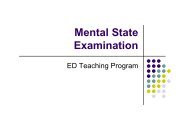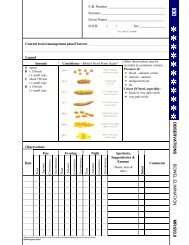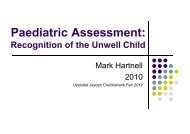Quality of Care Report - Ballarat Health Services
Quality of Care Report - Ballarat Health Services
Quality of Care Report - Ballarat Health Services
You also want an ePaper? Increase the reach of your titles
YUMPU automatically turns print PDFs into web optimized ePapers that Google loves.
Preventing Fallsin HospitalPatient falls are a challenging safetyand quality <strong>of</strong> care issue in the hospitaland residential setting where an ageingpatient population and persons withphysical and thinking limitations areexposed to unfamiliar and potentiallyhazardous surroundings (Tzeng, 2008).Falls prevention strategies at BHScentre on timely assessment, referralsfor intervention where needed andreassessment to evaluate improvement.National ComparisonFalls data is submitted to the AustralianCouncil on <strong>Health</strong>care Standards(ACHS) biannually and is thenbenchmarked against otherorganisations. At <strong>Ballarat</strong> <strong>Health</strong><strong>Services</strong>, the sub-acute and residentialservices areas were identified in 2007as being <strong>of</strong> most concern regardingfalls prevention.The Falls Minimisation Working Grouphas considered a number <strong>of</strong> strategiesto address the falls risk in these areas.These include:• A trial <strong>of</strong> hip protectors;• Investigation <strong>of</strong> medication relatedfalls; and• Individual resident and client falls riskpr<strong>of</strong>iles.Funding was also sought and approvedto commence a project in the subacutesetting to explore intrinsic andextrinsic risk factors for falls.Researchsub-acuteA study was commenced in July 2008to explore current practices around fallsassessment and prevention in the subacutesetting. This study which isscheduled to be completed at the end<strong>of</strong> 2009 should assist the organisationto reduce the incidence <strong>of</strong> falls in thisarea.Residential<strong>Ballarat</strong> <strong>Health</strong> <strong>Services</strong> is part <strong>of</strong> amulti-centre trial run by the NationalAgeing and Research Institute (NARI).This trial is funded through theCommonwealth Department <strong>of</strong> <strong>Health</strong>and Ageing and will be exploring therelationship between dementia andfalls. It will run from January 2008 toDecember 2009.<strong>Ballarat</strong> <strong>Health</strong> <strong>Services</strong> records all fallsinto a centralised management system,to enable analysis <strong>of</strong> falls across theorganisation. This contributes to theimplementation <strong>of</strong> strategies needed toaddress any issues.ReferencesTzeng Huey-Ming, Chang-Yi YinNurses’ solutions to prevent inpatientfalls in Hospital patient roomsNurse Econ. 2008: 26(3): 179-187Janetti Publications, Inc.Preventing PressureUlcersPressure Ulcers or bed sores are acommon problem in hospitals, and arerecognised internationally as one <strong>of</strong> thefive most common causes <strong>of</strong> harm topatients. Patients at greatest risk <strong>of</strong>developing pressure ulcers are thosewho are frail, elderly or immobile forlong periods <strong>of</strong> time. These are criteriathat fit many <strong>of</strong> the patients who aretreated at <strong>Ballarat</strong> <strong>Health</strong> <strong>Services</strong> andalmost all <strong>of</strong> those who live in ourresidential facilities.From 2003-2006, BHS participated in asurveillance program run by theVictorian <strong>Quality</strong> Council, collectinginformation on the incidence <strong>of</strong> skinbreakdown. This was the Pressure UlcerPoint Prevalence Survey (PUPPS). Theinformation was used to planprevention strategies and trackimprovement. In March 2008, the SkinIntegrity Harm Minimisation Grouprepeated the surveillance programlocally.The March study showed a 7.5 percent decrease in pressure ulcerprevalence from 2006. The statewidemean pressure ulcer prevalence in 2006was 17.6 per cent.Patients who are unable to movethemselves independently (immobility)were found to be most at risk <strong>of</strong>developing a pressure ulcer.<strong>Ballarat</strong> <strong>Health</strong> <strong>Services</strong> has introduceda number <strong>of</strong> systems and assessmentsto reduce pressure ulcers. A majorfactor in reducing pressure ulcerincidence is having a pressure ulcer riskassessment done as this then promptsstaff to put pressure relieving devices inplace if needed. Since the PUPPSsurveys began BHS risk assessment hasimproved significantly from 52 per centto 74 per cent in the most recentsurveys.Future DirectionsRecommendations arising from thelatest survey include:• Local ward initiatives to improveresults;• Consideration <strong>of</strong> need to purchasemore pressure relieving devices;• Increasing risk assessment education;The Department <strong>of</strong> Human <strong>Services</strong> hasnow mandated that organisationsreport pressure ulcer incidence and therate <strong>of</strong> risk assessment completion.<strong>Ballarat</strong> <strong>Health</strong> <strong>Services</strong> report theseseparately for the Base Hospital andQueen Elizabeth Centre sub-acute siteswhere they will be compared to similarorganisations.Key Findings PUPPS 3 PUPPS 32006 2008Summary DataPrevalence <strong>of</strong> patients with pressure ulcers 19.90% 12.40%Proportion <strong>of</strong> patients with pressureulcers present on admission (only) 42% 40%Primary associative risk factor Immobility ImmobilityPrevention and ManagementPressure ulcer assessment tool completed 52.60% 74%Use <strong>of</strong> pressure relieving devices 60.50% 85%<strong>Ballarat</strong> <strong>Health</strong> <strong>Services</strong> <strong>Quality</strong> <strong>of</strong> <strong>Care</strong> <strong>Report</strong> 2007-08 34



